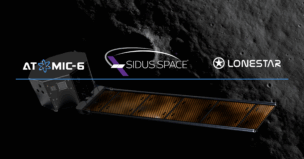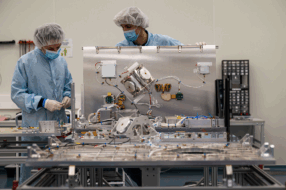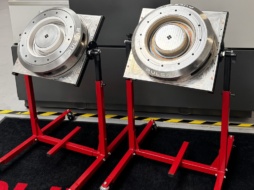If your phone dies on the Moon, Astrobotic has you covered.
Yesterday, the Pittsburgh-based company announced it has completed testing on a wireless charging system that can prep a variety of lunar surface infrastructure for the two-week lunar night.
The lunar colony: Big plans are in the works for a lunar and cislunar economy in the coming decades. Cislunar = the space between the Earth and Moon.
NASA’s Artemis program is set to return humans to the Moon’s surface in the next few years—potentially by 2025—and plenty of other companies are envisioning a bustling economy of humans living and working on the lunar surface.
In April, Astrobotic unveiled its Peregrine lunar lander, which is capable of delivering 500kg of payload to the surface. The lander’s first flight is scheduled for late this year as part of NASA’s Commercial Lunar Payload Services (CLPS) program.
Wireless charging: The Moon doesn’t provide the easiest living environment to humans—or to robots. One of the biggest challenges is the 14-day long lunar night, which would keep lunar infrastructure from using solar power, the current space-based power source of choice.
The wireless charging system converts power from a lunar lander or vertical solar array into wireless power, which is then transmitted to an outside device (for example, a rover or lunar habitat) through a transmitter antenna coil. That coil has to be outside the power source, meaning it is exposed to extreme hot and cold temperatures.
- Astrobotic tested the system at its Pittsburgh headquarters in extreme heat environments and in regolith, similar to the loose, dusty material coating the surface of the Moon.
- In these situations, NASA Glenn Research Center found that the charging system surpassed its performance goals.
“By enabling night survival, we’re opening…the Moon to more science activity, for much longer than ever before,” Jay Eckard, Senior Project Manager for Lunar Surface Systems at Astrobotic, said in a press release.
Zoom out: NASA is currently working with nine CLPS providers. “The whole group of CLPS landers excites me, because…we’re going to have multiple landings on the Moon from these private companies that have been enabled by NASA,” Rob Meyerson, former president of Blue Origin and CEO of Delalune Space, told us last week on the Pathfinder podcast.
“When we get there, no matter what business it is that you’re going to build, you’re going to need mobility. You’re going to need to land. You’re going to need a cargo capability to service, either bring more robots or bring supplies, for the humans that are there.”




